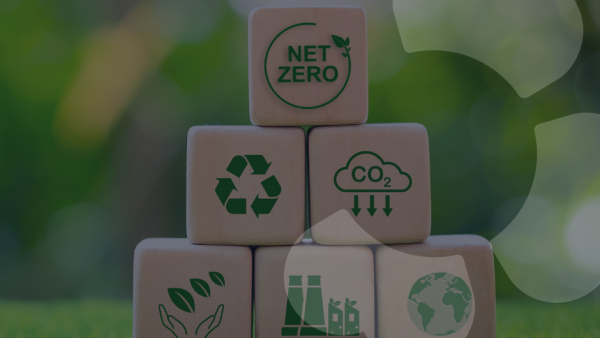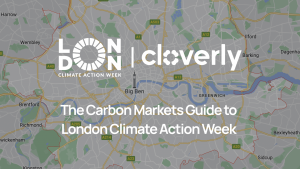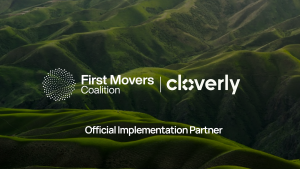As the saying goes, a week is a long time in climate. This week the SBTi evolved its policy on scope 3 emissions to accept the use of ‘environmental attribute certificates,’ including carbon credits from the voluntary carbon market.i Historically, the SBTi advocated for full decarbonization before addressing residual emissions, which has constrained growth in the voluntary carbon market. This shift was big news within the sustainability community. It means Chief Sustainability Officers (CSOs) transitioned from a world where they could not use carbon credits in their supply chains to one where they could. So, there’s a lot to unpack as to the why and the how.
Watch the webinar “The Role of Carbon Credits in Credible Climate Claims” to learn how to leverage carbon credits in your decarbonization journey and communicate your progress with integrity.
How the SBTi stance has impacted critical climate action
The question of beyond value chain mitigation has existed for a while. The SBTi has long advocated for 90% decarbonization first before addressing truly residual emissions by 2040 or 2050 (when carbon credits can be utilized). This approach has hindered the flow of procurement dollars into carbon markets, resulting in lost decades of climate action. Financial incentives are essential for carbon project suppliers to scale technologies rapidly enough to hit the gigatonne capacity needed. This is not an either / or conversation and there are numerous reasons why this outdated thinking hinders robust climate action by enterprises.
The moral hazard argument doesn’t work anymore.
However, the landscape is shifting. Companies are decarbonizing faster than ever. In fact, companies who focus on emissions reductions and carbon credits in parallel are decarbonizing 1.8x faster than their peers. This means companies who use carbon credits take decarbonization more seriously. We see this in many of the enterprise businesses we work with at Cloverly who have science backed targets and use carbon credits simultaneously. They are further along the journey and more advanced than their peers. This underscores a fundamental shift: carbon credits are not a distraction from decarbonization efforts but a catalyst for accelerated progress.
The science demonstrates net zero does not exist without carbon credits scaling
Every scenario from accredited industry sources shows that scaling the carbon market is essential for the private sector and the planet to reach net zero. For instance, scenarios in the IPCC‘s Shared Socioeconomic Pathways (SSPs) modeling for a net zero future and the UN Global Stocktake confirm this. There is no sustainable future without carbon credits, particularly carbon dioxide removal (CDR), reaching gigatonne scale. CDR needs catalytic climate finance in this decade for us to be within shooting distance of the 1.5-degree Celsius goal outlined by the Paris Agreement.
Carbon markets 2.0: A high-integrity approach
Building on this momentum, carbon markets 2.0 heralds a new era of high-integrity and robust governance across the voluntary carbon market. On the supply side, the ICVCM is establishing guardrails for carbon project integrity through its Core Carbon Principles. At the same time, the VCMI is taking on the position of custodian for credible corporate climate claims. Mandatory reporting frameworks like the EU CSRD and the SEC Climate Disclosure Rule are promoting greater market transparency. And, at COP28, key players from the GHG Protocol, SBTI, VCMI and ICVCM aligned on a high-integrity roadmap.
More collaboration is needed.
Solving the climate crisis requires more collaboration; no single organization can tackle it alone. We anticipate increased collaboration and interoperability of guidelines across key governance bodies in the carbon market as they unite toward this shared goal. For example, ICVCM on the supply side and VCMI who late last year introduced the scope 3 flexibility rule to expand climate finance in this decade. SBTi’s partnership with peer organizations to drive high-quality and high-integrity solutions also bolsters their leadership role.
What should sustainability leaders do?
The gold standard of net zero
SBTi’s updated policy offers enterprises with complex distributed supply chains a streamlined path to achieving the gold standard. In recent months, some businesses have pulled back from science validated targets in their net zero strategies. SBTi’s revised policy creates a bridge for those companies to recommit to science-based decarbonization and mitigation, but active dialogue is key. For businesses with significant indirect emissions that are hitting all of their reduction targets, SBTi’s scope 3 option now provides a viable path for attaining the gold standard.
Flight to quality
The flight to quality in carbon markets will only become more acute due to this development. Businesses engaging with environmental attribute certificates will need to adhere to a high-integrity approach with a lot of reporting scrutiny. As a sustainability leader, ensure you are working with a credible, independent platform aligned to supply-side integrity across carbon markets.
Decarbonizing for our planet’s future
The goal posts have not changed. We need to halve emissions by 2030 and achieve net zero by 2050. In this decade, we must remove over 10 gigatonnes of carbon from the atmosphere annually. This challenge isn’t about choosing one method over another. Prioritizing decarbonization is critical, but we also need to engage mechanisms such as a voluntary carbon market (VCM) in parallel. Without fully unlocking the VCM’s potential, our ability to reach the Paris Agreement is at severe risk. Dismissing carbon credits means advocating for less climate action. As sustainability leaders, we must champion both.
To find out how to make credible climate claims with high-quality carbon credits, watch the webinar.
i More information pending till July 24th on reporting and guidance.





